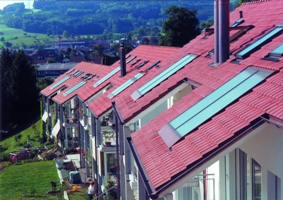Study on Solar Thermal Municipalities in Italy
July 20, 2009Italian Solar Thermal Municipalities
The Italian “Renewable Municipalities Report 2009” is very likely the most comprehensive European study about renewable activities on a municipality level. It lists 2,996 Italian municipalities that are currently using solar thermal technology.
Figure: Legambiente
The study called “Rapporto Comuni Rinnovabili 2009” was conducted by Legambiente, the League for the Environment. It is the fourth report of its kind, covering not only solar thermal, but also photovoltaic, biomass, wind, geothermal and hydroelectric energy (see the attached document).
Municipalities which want to qualify as a “Solar Thermal Municipality” – as laid out by the authors of the study – have to install a collector area of 264 m2 per 1,000 inhabitants. This target is oriented on what Austria reached at the end of 2008.
At present, 36 municipalities have reached the target and another 11 will follow this year. The study also states the Top 50 of solar thermal municipalities – such as the village Don, based in Trentino. It is the frontrunner of the solar thermal survey, possessing an extrapolated average value of 1,036 m² per 1,000 inhabitants. Nevertheless, one must consider that Don is a very small village with only 224 people living there. The following chart will show the top five communities of the survey. Among bigger cities, only Campoformido in Udine fulfilled the requirements for being a Solar Thermal Municipality.
 Top five of the “Solar Thermal Municipalities” of the survey with the highest newly installed collector area rate per 1,000 inhabitants Source: Legambiente
Top five of the “Solar Thermal Municipalities” of the survey with the highest newly installed collector area rate per 1,000 inhabitants Source: Legambiente
The Legambiente study also covers solar obligations. Edoardo Zanchini, the Director of Energy at Legambiente, summarized the results in his presentation during the Solarexpo in Verona this May (see attached document). There are more than 400 building regulations for solar thermal applications in Italy, but only 167 municipalities have a building regulation for newly constructed, renovated or reconstructed buildings. Most of them look to the national solar building code, which indicates that new or renovated buildings must possess solar water heater installations that meet at least 50 % of the overall heating requirements. Unfortunately, the government has not yet published specific application rules, so that the national building code has not yet been operational.
110 of the municipalities additionally try to promote solar thermal applications by introducing direct incentives. Besides that, 22 municipalities are requesting a share of more than 60 % in utilisation of solar thermal energy – not only for domestic hot water, but also for swimming pools, hospitals, newly built restaurants and bars. Supermarkets and shopping centres, however, will only need a share of 30 % in solar thermal energy.
A closer look at the situation of solar building codes in Italy is worth it, thinks Zanchini and announced a new study: “We are working on solar regulations and the results will be presented in the second report of the ONRE at the Saie Fiera in Bologna, at the end of October.”
More information:
Edoardo Zanchini
e.zanchini@legambiente.eu
http://www.legambiente.eu
The text was written by communication specialist Hanna Schober based in South Africa. Schober@solrico.com


